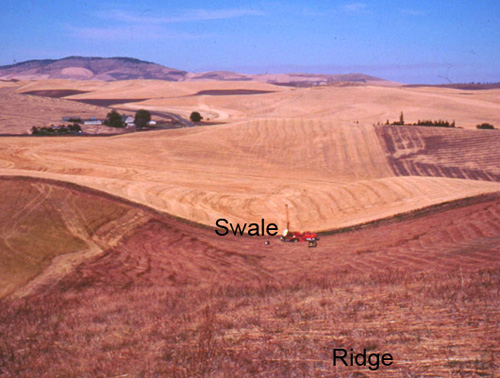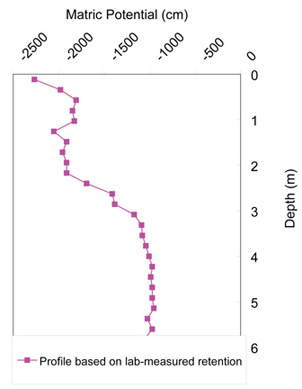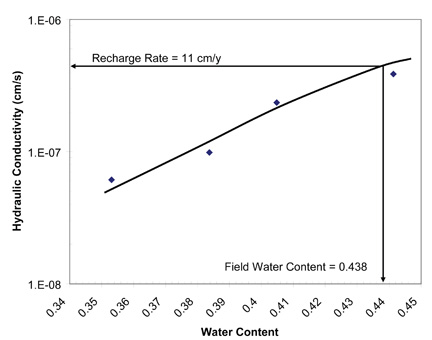




The Palouse site, a semi-arid agricultural area near Pullman, WA, is an example where flow is steady and recharge was estimated directly from laboratory-measured hydraulic condictivity (Nimmo and others, 1994). The site is part of an extensive loess deposit that forms the rolling hills topography pictured to the left. Depth to the water table varies from about 7 to 20 m below land surface being deeper where surface elevations are higher.
Core samples were obtained from 3 to 20 m using a ring-lined, split-barrel sampler pushed ahead of a hollow-stem auger while drillig. Samples were sealed in plastic and weighed in the field immediately after collection and were stored in a humidified chamber at a controlled temperature of 22 degrees centigrade to minimize evapration. Steadiness of flow was asessed by constructing matric potential profiles from gravimetrically-determined water content values paired with laboratory-measured water retention characteristic curves (see graph below). Flow was determined to be steady below a depth of about 3 m.

Recharge indications from the Darcian-SSC method with core samples from 2 locations (a ridge top and a swale, photo above) were consistent with the previously estimated value of 8 cm/year at the site Bauer and Vaccaro (1990). Point estimates of recharge rate exceeded this value slightly in the swale and fell short of it on the ridge. This is consistent with the simplest hydrologic interpretation, that water mostly runs off the ridge top but tends to collect in the swale, so that both infiltration and recharge are greater in the swale. The graph (left) shows the measured hydraulic conductivity curve for a minimally disturbed core sample retrieved from the swale within the zone of steady flow (4.3 m) and the resulting calculated recharge rate of 11 cm/y for a field volumetric water content of 0.438.

The study at this site showed that the Darcian-SSC method has a fundamentally sound physical basis independent of other methods (e.g. water balance, tracers) and can be implemented in a practical way. The chief publication of the basic method and the Palouse study is Nimmo and others (1994).
| National Research Program | USGS | Water Resources | Unsaturated Zone Flow Project Home Page |